10 workspaces doing great things on social media
Kevin C. Whelan helps flexible workspace operators become leaders in competitive markets. In his article on how to do social media properly, he says:
“Social media is not a sales tool. It’s not a lead generation tool (unless you’re advertising). It’s a relationship tool. It’s a brand-building tool.”
At Nexudus, we couldn’t agree more.
It can be tempting for anyone running a business to get tied up in the minutiae of social media. How many leads come through our social channels? How many followers do we have on Instagram? Should we be jumping on the latest trend?
The fact is, if you create authentic content, the results will follow - eventually.
Resign yourself to the fact that these results might not be measurable straight away. It could be a case of someone seeing your social post and sharing it with a friend.
The friend in question may follow you and end up reaching out a few months down the line when they’re tired of working from home and need a friendly coworking space to work in.
Whether you run a solo indie workspace or a growing chain of offices, here are a few workspaces doing great things on social media right now.
1. The Hub Coworking on TikTok
Location: Ecuador
Social media channel: @thehub.coworking on TikTok
The majority of flexible workspace operators aren’t on TikTok. It’s a relatively new social media channel, so that’s understandable. However, the platform recently revealed it has 1 billion active global users, so it’s definitely worth exploring.
The Hub Coworking in Ecuador does a fabulous job of showcasing its space and members in a fun and engaging way, set to music. Check it out here.
2. Common Desk on Instagram
Location: US
Social media channel: @commondesk on Instagram
The great thing about Common Desk’s Instagram feed is that it showcases its space, members, employees - even the resident dogs get their fair share of the limelight.
The company also uses Instagram as a platform for updates and announcements, such as this one celebrating the opening of a new venue:
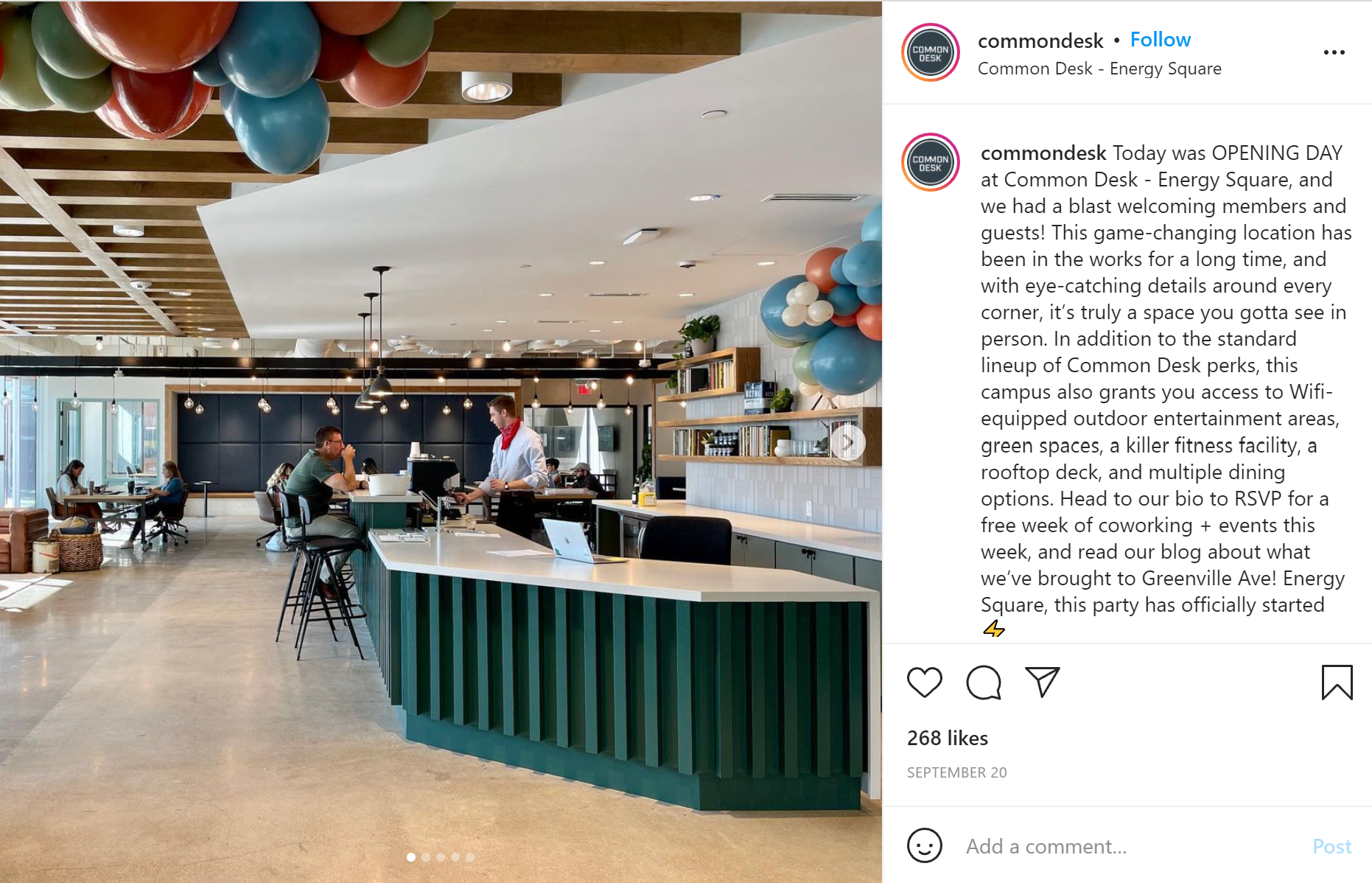
3. Nottingham Offices on Twitter
Location: UK
Social media channel: @nottmoffices on Twitter
As a coworking operator, it’s really difficult to do Twitter well (which is probably why many don’t bother). We think Nottingham Offices are a good example of how it can be used effectively. All you need is a photo, some hashtags and a sense of humour:

4. Serendipity Labs on Facebook
Location: US & UK
Social media channel: @SerendipityLabs on Facebook
We love this post by Serendipity Labs.
Instead of showcasing an empty reception area, it focuses on the employees. And instead of simply stating their name and job title, it humanises them by revealing something about who they are outside of work.
We particularly like that Blake “loves utilizing our call rooms & meeting rooms because it’s the perfect quiet space to tape an audition or do an online rehearsal.”
5. Coworking Tulum on Instagram
Location: Mexico
Social media channel: @coworking.tulum on Instagram
Coworking Tulum dedicates its Instagram feed to its members. It uses the platform to tell members’ stories while facilitating a bit of word of mouth marketing for its own business at the same time!
In the words of one member:
“I arrived in Tulum not knowing a soul, quit my job, got a whole new jungle family, set up my own business and so, so much more. A big part of this was made all the easier thanks to the epic-ness of @coworking.tulum.”
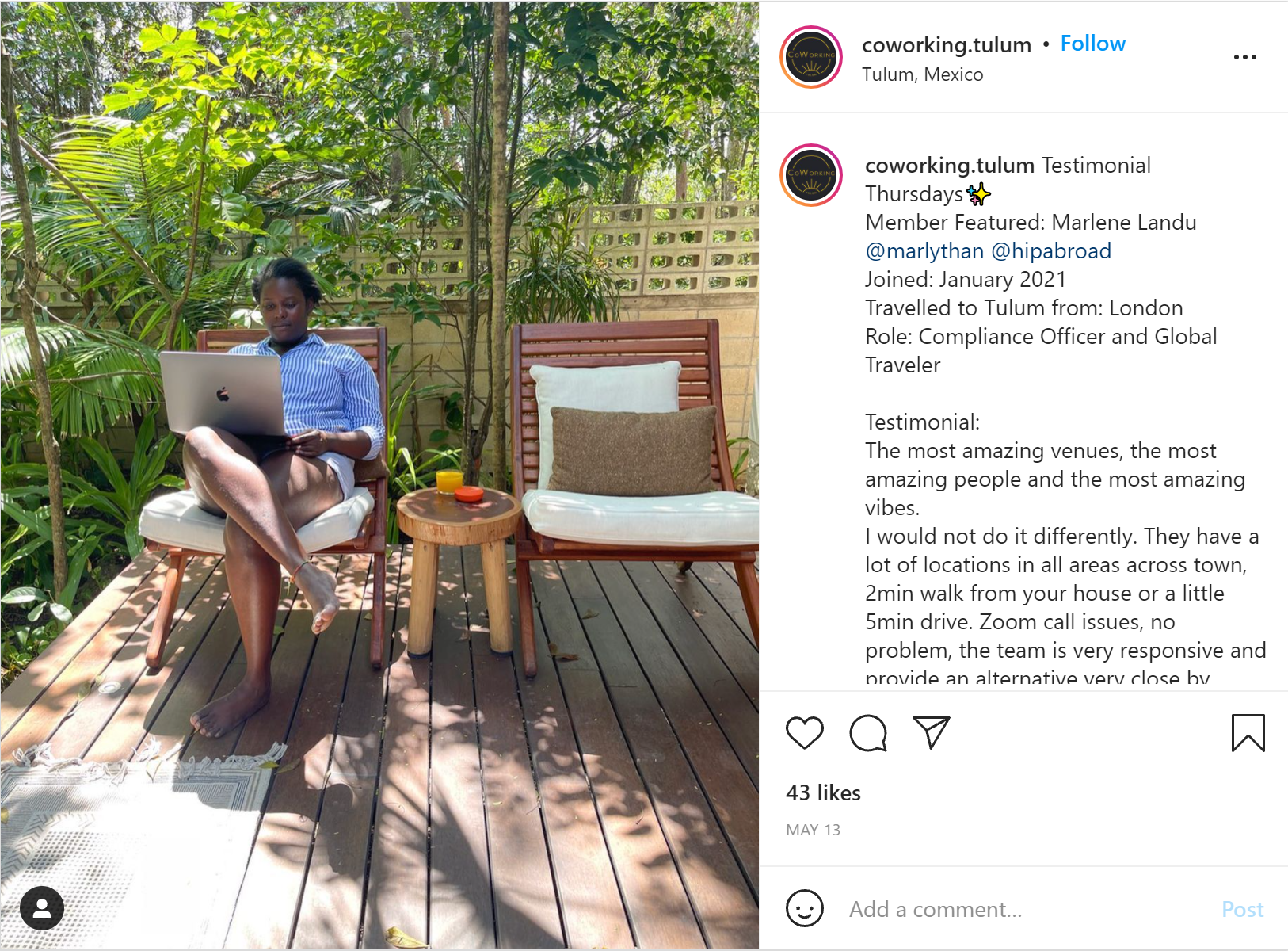
6. Aticco Workspaces on Instagram
Location: Madrid
Social media channel: @atticoworkspaces on Instagram
Aticco Workspaces certainly knows how to do Instagram well. Check out the Stories Highlights on their profile - they’re well-presented and reveal different aspects of the space and the community that calls it home.
Here’s a translation of the post below:
“Being part of #Aticco has helped us to reinvent ourselves as a company.”
As highlighted by our #coworker Sergio Romero, founding partner of @mdk_es, developing your project at Aticco means working in an international environment and being in contact with professionals from various areas, a key factor to drive innovation in your business model.
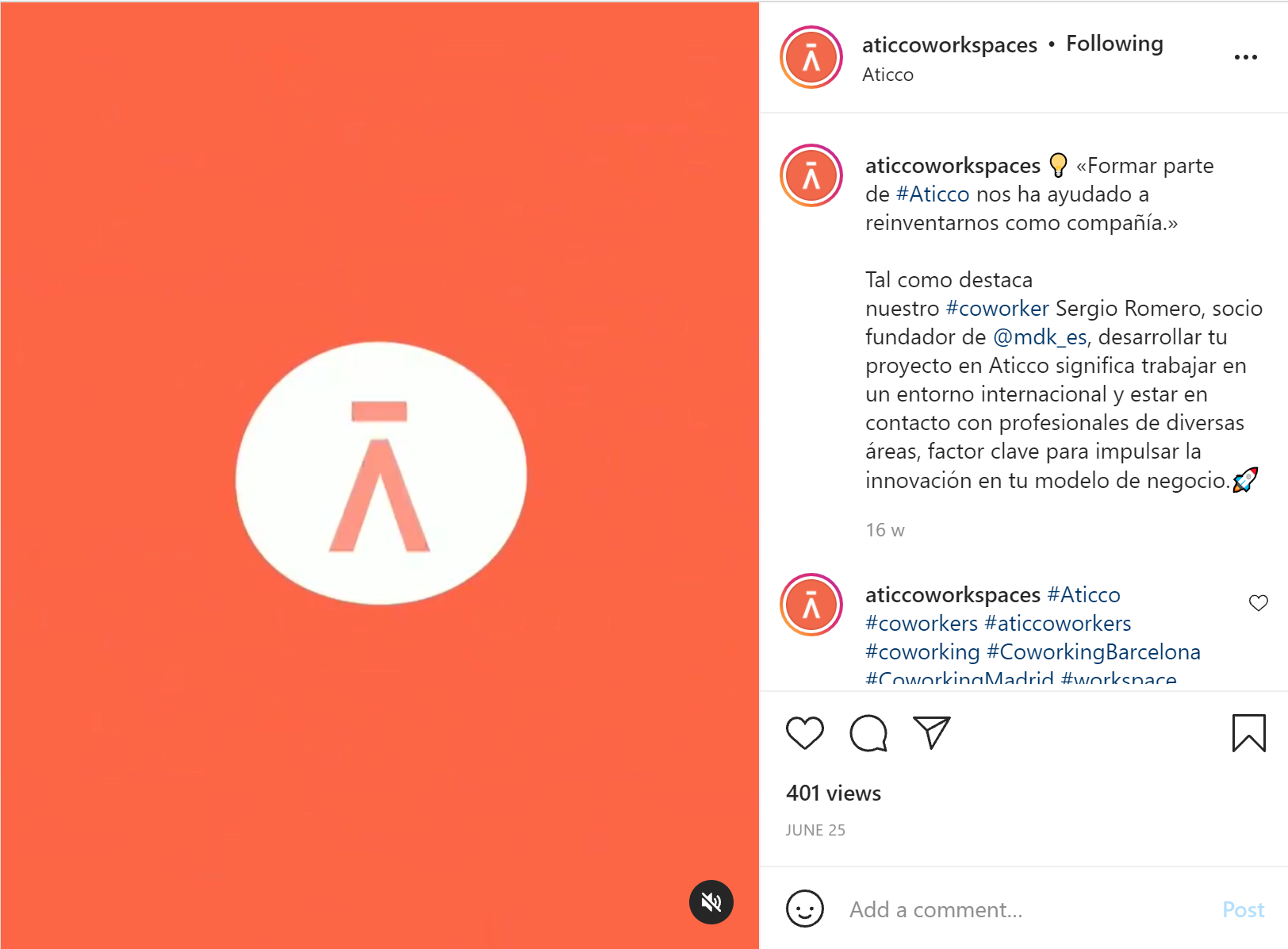
7. Coworking Lounge Tessinerplatz on LinkedIn
Location: Zurich
Social media channel: @CoworkingLoungeTessinerplatz on LinkedIn.
What’s an effective way to get people to engage with your content on LinkedIn? A) Share interesting, authentic and professional content with lots of visuals; and B) tag the relevant people in your post.
Not only is this a way of showing your appreciation to those who participated in your event, but it also prompts the participants to join the discussion.
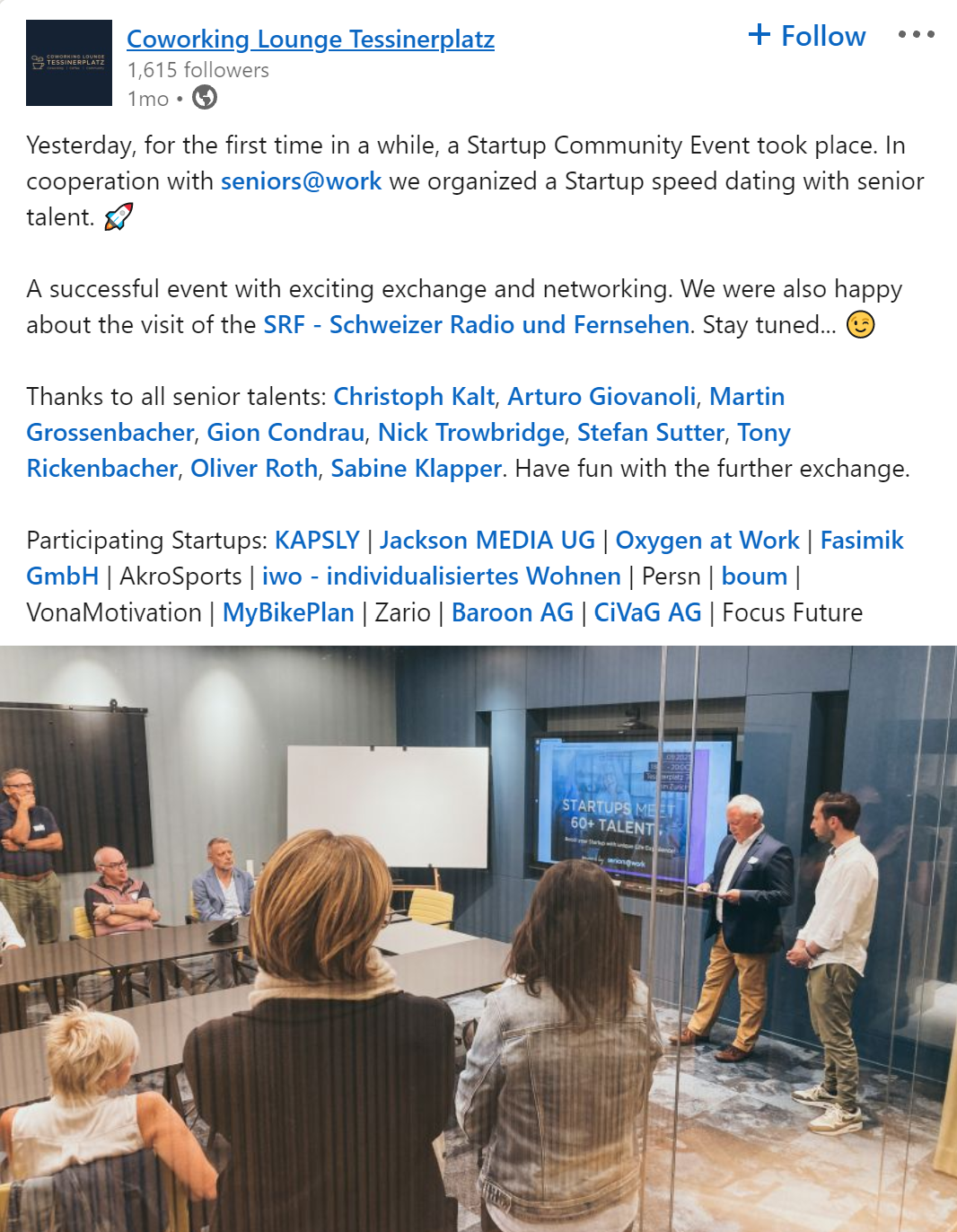
8. CoHive Coworking on Instagram
Location: Indonisia
Social media channel: @cohivespace on Instagram
Like Aticco, we were impressed with CoHive’s Stories Highlights - see how they spell out “the future of work space is here.” Aside from clever visuals, we like how this operator combines functional images of its space with pictures of members.
CoHive also shares useful tips and advice covering everything from how to manage feelings of anxiety at work to how to create a productive workspace.
We particularly like this post celebrating Indonesian Farmer’s Day and Supporting Indonesian Agriculture:

9. B. Amsterdam on LinkedIn
Location: Netherlands
Social media channel: @B.Amsterdam on LinkedIn
B.Amersterdam really maximises LinkedIn’s potential by using it to attract new talent as well as promote events and members. As you can see, earlier this year the company posted a callout for a new Junior Event Manager.
LinkedIn is a great recruitment tool for coworking spaces because it’s free, and if your post is crafted effectively, it can reach an extensive network of potential candidates. LinkedIn also lets you post vacancies on the Jobs section. Take a look at this great example from B.Amsterdam.
10. Torno Colab on Instagram
Location: Ecuador
Social media channel: @tornocolab on Instagram
Torno Colab’s Instagram feed offers the perfect blend of member spotlights, events, architecture photos and, of course, dogs.
Although there are plenty of eye-catching images to choose from, we’re fond of this one which depicts the space in a disused state, before it was lovingly transformed into the vibrant community it is today.
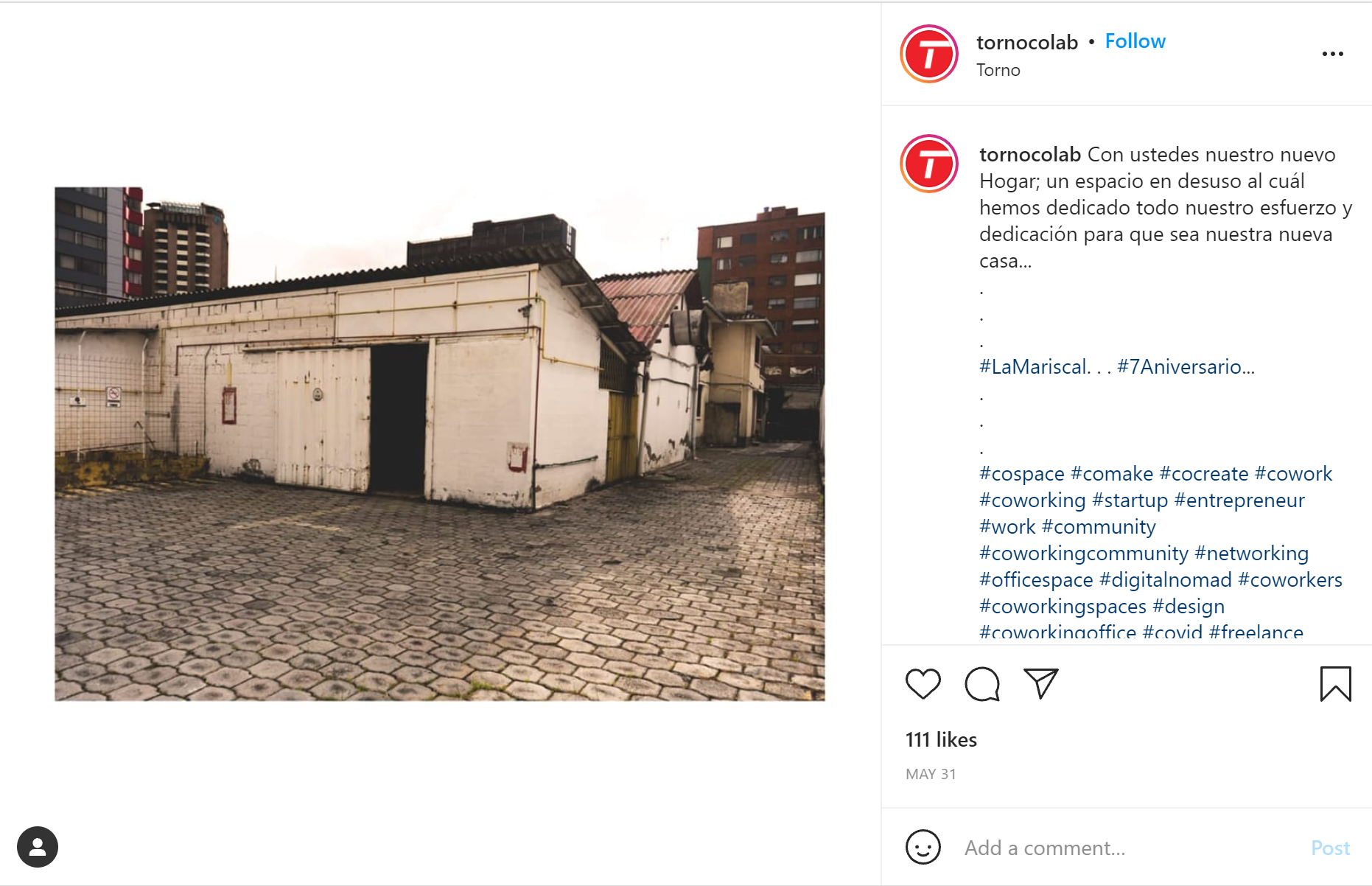
Do you think your coworking space’s social media channels deserve a mention? Mention us in your posts and we’ll return the favour!
Scroll to the bottom of this page for our links...
Related stories
Global Coworking Trends and Opportunities for 2025
Now well into 2025, the coworking industry continues to demonstrate strong momentum. With demand for coworking spaces remaining steady around the globe, it's clear that coworking is not just enduring—it's thriving. Let’s explore the major trends and opportunities shaping the global coworking landscape this year.
Creating Events that Drive Community Engagement in Coworking Spaces
Community is everything in coworking, but a genuine sense of connection between members doesn’t magically happen overnight or by chance. Often, meaningful relationships take intentionality, effort, and time to build, with events being an effective vehicle for bringing people together around shared interests, goals, and experiences, creating opportunities for collaboration, and a thriving coworking culture. This article looks at creating events that drive community engagement in coworking spaces.
Liz Elam: ‘Community is the number one amenity in coworking spaces’
A household name in the global coworking industry, Liz Elam, is the founder of one of the world’s best coworking event series: GCUC. Liz’s coworking roots began in 2010, when she established Link Coworking – a welcoming, affordable, and professional coworking space – in her hometown of Austin, Texas. Link Coworking achieved incredible success, expanding across three locations and becoming the fourth-largest coworking brand in Austin. It was sold in 2019, making Liz the first woman globally to exit a coworking brand.
Key Takeaways from the Coworking Alliance Summit 2025
Gathering online for the Coworking Alliance Summit last week, members of global coworking alliances, coworking spaces, and community leaders came together to navigate global issues, strengthen ties across the coworking industry, and work collectively towards future goals.
5 Ways to Reduce Noise in Open Offices & Coworking Spaces
Some people like working against a background of noise, while for others it’s their worst work nightmare. The truth is, our relationship with noise depends on our own preferences and the nature of our work.
Key takeaways from the Workspace Design Show 2025
London’s Workspace Design Show is undoubtedly one of the best coworking events of 2025. For one, the exhibition (held at Islington’s Business Design Centre) features a host of innovative and creative workspace design solutions tailored to the needs of modern workplaces.
What Is Workplace Management and Why Does It Matter?
There has always been a need for workplace management – the process of organising and optimising physical spaces, resources, and operations to support people’s needs. But, as 28% of UK working adults were reported to work in a hybrid capacity last autumn (by the Office for National Statistics), the question of ‘why workplace management matters’ is more critical than ever. Let’s look at the workplace management benefits for your operations.
10 Smart Goals for your Coworking Space: How to Set & Achieve Business Objectives
Coworking is synonymous with creativity, collaboration and productivity. Businesses and freelancers love coworking spaces because (by surrounding themselves with fellow workers) they’re more likely to achieve their goals. The coworking environment, while social, is set up to facilitate focused, distraction-free working.
The Best Coworking Events in 2025: Must-Attend Gatherings for Professionals
Managing coworking spaces is an all-encompassing role, often leaving operators, owners, and community managers with little time to focus on personal growth or draw inspiration from others.
10 Award-winning Coworking Space Designs: A Comprehensive Guide
Vibrant, contemporary workspaces create an undeniable ‘wow’ factor. Textured designs and ambient lighting make spaces feel warm and cosy, while natural elements and biophilic design features have literal mood-boosting properties.

